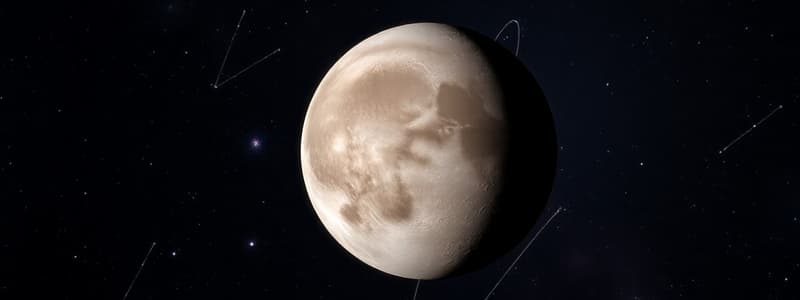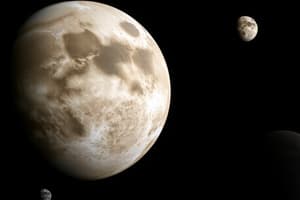Podcast
Questions and Answers
What are the names of two very large impact basins on Mercury?
What are the names of two very large impact basins on Mercury?
- Atlas and Hercules
- Apollo and Tycho
- Caloris and Rachmaninoff (correct)
- Ferdinand and Galileo
What is the approximate thickness of Mercury's outer shell?
What is the approximate thickness of Mercury's outer shell?
- 250 miles (about 400 kilometers) (correct)
- 1,000 kilometers
- 100 kilometers
- 600 kilometers
What is a key characteristic of Mercury's atmosphere?
What is a key characteristic of Mercury's atmosphere?
- It is a thick atmosphere similar to Earth's.
- It is composed mostly of nitrogen.
- It is a dense atmosphere containing breathable air.
- It is a thin exosphere made up of different atoms. (correct)
Which spacecraft was the first to orbit Mercury?
Which spacecraft was the first to orbit Mercury?
What primarily contributes to the generation of Mercury's exosphere?
What primarily contributes to the generation of Mercury's exosphere?
What feature does Mercury have that rises hundreds of miles long?
What feature does Mercury have that rises hundreds of miles long?
How does Mercury's internal structure compare in density to other planets?
How does Mercury's internal structure compare in density to other planets?
Which spacecraft used a gravity assist to change its flight path?
Which spacecraft used a gravity assist to change its flight path?
What is the meaning of the word 'planet' derived from ancient Greek?
What is the meaning of the word 'planet' derived from ancient Greek?
According to the IAU, which of the following is NOT a requirement for an object to be classified as a planet?
According to the IAU, which of the following is NOT a requirement for an object to be classified as a planet?
What significant change did the IAU's 2006 resolution bring about regarding Pluto?
What significant change did the IAU's 2006 resolution bring about regarding Pluto?
Which celestial body is included in the category of dwarf planets according to the IAU?
Which celestial body is included in the category of dwarf planets according to the IAU?
What new category was established by the IAU alongside the definition of a planet?
What new category was established by the IAU alongside the definition of a planet?
Which of the following is NOT considered a dwarf planet as per the IAU's classification?
Which of the following is NOT considered a dwarf planet as per the IAU's classification?
What defines a planetary characteristic of bodies in the solar system?
What defines a planetary characteristic of bodies in the solar system?
What is the approximate number of dwarf planets believed to exist in the solar system, according to the document?
What is the approximate number of dwarf planets believed to exist in the solar system, according to the document?
What is the average age of surface features on Venus?
What is the average age of surface features on Venus?
Which region of Venus is around the size of Australia?
Which region of Venus is around the size of Australia?
What characteristic distinguishes Venus' surface from that of other rocky planets?
What characteristic distinguishes Venus' surface from that of other rocky planets?
What primarily composes the atmosphere of Venus?
What primarily composes the atmosphere of Venus?
What is notable about the mountain found on Venus?
What is notable about the mountain found on Venus?
What type of magnetic field does Venus have?
What type of magnetic field does Venus have?
What unique geological feature can be found on Venus, formed by viscous lava?
What unique geological feature can be found on Venus, formed by viscous lava?
What temperature condition occurs in Venus' atmosphere at higher altitudes?
What temperature condition occurs in Venus' atmosphere at higher altitudes?
What is the name of the largest volcano in the solar system located on Mars?
What is the name of the largest volcano in the solar system located on Mars?
How does the size of Valles Marineris compare to Earth's Grand Canyon?
How does the size of Valles Marineris compare to Earth's Grand Canyon?
What aspect of Mars' atmosphere makes the sky appear hazy and red?
What aspect of Mars' atmosphere makes the sky appear hazy and red?
What type of water is currently found on Mars?
What type of water is currently found on Mars?
What is the height of Olympus Mons compared to Mount Everest?
What is the height of Olympus Mons compared to Mount Everest?
Mars' thin atmosphere provides little protection against what?
Mars' thin atmosphere provides little protection against what?
What geological features suggest that Mars had a watery past?
What geological features suggest that Mars had a watery past?
Which of the following gases is NOT a significant component of Mars' atmosphere?
Which of the following gases is NOT a significant component of Mars' atmosphere?
What is the primary objective of the DAVINCI+ mission?
What is the primary objective of the DAVINCI+ mission?
How does the solar wind affect Venus?
How does the solar wind affect Venus?
Which will be the first U.S.-led mission to Venus’ atmosphere since 1978?
Which will be the first U.S.-led mission to Venus’ atmosphere since 1978?
What type of data will DAVINCI+ provide regarding Venus' geological features?
What type of data will DAVINCI+ provide regarding Venus' geological features?
What was the significance of NASA's Mariner 2 mission?
What was the significance of NASA's Mariner 2 mission?
What is the primary focus of NASA’s planned VERITAS mission?
What is the primary focus of NASA’s planned VERITAS mission?
What shaped the induced magnetic field around Venus?
What shaped the induced magnetic field around Venus?
What unique geological features on Venus are potentially comparable to Earth's continents?
What unique geological features on Venus are potentially comparable to Earth's continents?
Study Notes
Planets
- Definition: A celestial body that orbits a star, large enough to be spherical due to its own gravity, and has cleared its neighborhood of other objects of similar size
- IAU: International Astronomical Union established a definition of a planet in 2006, which led to Pluto's reclassification as a dwarf planet.
- Dwarf planets: Pluto, Eris, Ceres, Haumea, and Makemake
Mercury
- Density: Second densest planet after Earth due to its large metallic core
- Surface: Evidence of volcanic activity, large impact basins, cliffs, and smooth terrain
- Atmosphere: Thin exosphere composed of oxygen, sodium, hydrogen, helium, and potassium
- Exploration: Mariner 10 was the first spacecraft to study Mercury, followed by MESSENGER and BepiColombo
Venus
- Surface: Volcanic features like valleys, mountains, and volcanoes
- Hottest surface in the solar system: Due to its dense carbon dioxide atmosphere
- No magnetic field: Venus has an induced magnetic field due to the interaction of the Sun's magnetic field and its ionosphere
- Exploration: Mariner 2 was the first spacecraft to visit Venus. NASA is planning two new missions: VERITAS and DAVINCI+.
Mars
- Largest canyon system: Valles Marineris, larger than the Grand Canyon
- Largest volcano in the solar system: Olympus Mons, three times taller than Mt. Everest
- Watery past: Evidence of ancient river valleys, deltas, and lakebeds
- Present water: Water is found as ice under the surface in polar regions and as briny water flowing seasonally
- Atmosphere: Thin atmosphere, dominated by carbon dioxide, nitrogen, and argon
Studying That Suits You
Use AI to generate personalized quizzes and flashcards to suit your learning preferences.
Related Documents
Description
Test your knowledge about planets with a focus on Mercury and Venus. Explore their characteristics, explorations, and reclassification of celestial bodies like Pluto. This quiz covers essential facts about these intriguing planets in our solar system.




